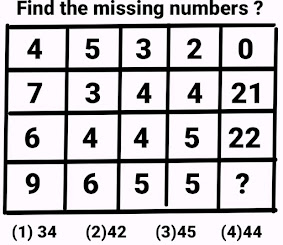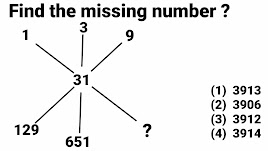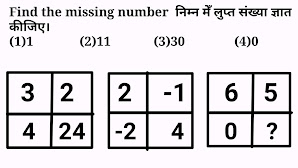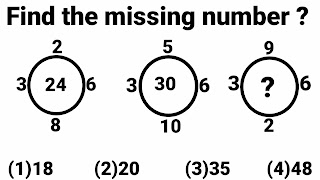Maths Reasoning questions with answers for competitive exams
Ten most important maths reasoning questions for competitive exams.
Question #1
 |
| Reasoning questions |
This box problem consists of four rows and five columns. To find the value of question marks in fifth column of fourth row we have to combine two columns at a time and then take the difference of combination two other rows.
Formula :-
The difference of product of 1st and 4th column and sum of 2nd and 3rd column.
(Number in 1st column × Number in 4th column ) - (Number in 2nd column + Number in 3rd column) = Number in 5th column
( 4 × 2 ) - ( 5 + 3 ) = 8 - 8 = 0 (1st row 4th column)
( 7 × 4 ) - ( 3 + 4 ) = 28 - 7 = 21(2nd row 4th column)
( 6 × 5 ) - ( 4 + 4 ) = 30 - 8 = 22(3rd row 4th column)
( 9 × 5 ) - ( 6 + 5 ) = 45 - 11 = 34 = ? (The value of question mark)
Option (2)34 is correct option.
Question #2
Since the question mark is in the middle of 3rd figure. So the value of question mark will be calculated with the help of remaining four numbers around this figure in the same way, the middle numbers in 1st and 2nd figure can be calculated with the help of remaining four numbers around each figure. This question mark value can be found by two methods.
1st Method
( 52 - 41 ) + 5 = 11 + 5 = 16 ( Middle number in 1st figure )
( 92 - 85 ) + 5 = 7 + 5 = 12 ( Middle number in 2nd figure )
( 126 - 113 ) + 5 = 13 + 5 = 18 ( Middle number in 3rd figure )
Option (3)18 is correct option
2nd Method
[(4 + 2) - (5+ 1) + 16]= (6 - 6) + 16 = 0 + 16 = 16 (Middle number in 1st figure )
[(8 + 2) - (9 + 5) + 16]= (10 - 14) + 16 = -4 + 16 = 12 (Middle number in 2nd figure )
[(11+ 6 ) - (12+ 3) + 16]= (17 - 15) + 16 = 2 + 16 = 18 (Middle number in 3rd figure )
Option (3)18 is correct option.
Question #3
Formula :-
2³ + 1³ + 3³ = 8 + 1 + 27 = 36 (4th row 1st column)
0³ + 4³ + 3³ = 0 + 64 + 27 = 91 (4th row 3rd column)
4³ + 2³ + 1³ = 64 + 8 + 1 = 73 = ? (4th row 2nd column)
Option (D)73 is correct option.
Question #4
This box problem also consists of four rows and three columns. To find the value of question marks in 4th row of 3rd column we have to combine three rows at the same time.
Formula :-
Sum of Product of hundred times of number in 2nd row and product of numbers in 1st and 3th rows is equal to Number in 4th row.
100 × ( Number in 2nd row ) + ( Number in 1st row ) × ( Number in 3rd row ) = Number in 4th row
(5 × 100) + ( 7 × 10 ) = 500 + 70 = 570 (4th row 1st column)
(3 × 100) + ( 8 × 11 ) = 300 + 88 = 388 (4th row 2nd column)
(1 × 100) + ( 2 × 9 ) = 100 + 18 = 118 (The value of question mark)
Option (B)118 is correct option.
Question #5
Formula :-
Question #6
Formula :-
Question #7
Formula :-
Question #8
Formula :-
Question #9
There are three figures in this problem. Every figure consists of three numbers one in the top of the figure and two numbers are in the bottom line. In every figure the number in the top of the figure is made up of remaining two numbers which are in the bottom line. The number in the top of the figure can be calculated by using any mathematical operations with the help of remaining two numbers. The mathematical operation we use to calculate the number in the 1st figure must be same in all the remaining two figures.
Formula :-
Difference of squares of numbers in the two branches of given figure is equal to number in the top of the same figure.
a² - b² = c (Number to be calculated)
1st Figure
16² - 7² = 256 - 49 = 207
2nd Figure
12² - 8² = 144 - 64 = 80
3rd Figure
25² - 21² = 625 - 441 = 184 (The value of question mark)
Option (2)184 is correct option.Question #10
1st Box
Product of numbers in three small boxes is equal to number in 4th box
4 × 3 × 2 = 24
2nd Box
Product of numbers in three small boxes is equal to number in 4th box
(-2) × 2 × (-1) = 4
3rd Box
Product of numbers in three small boxes is equal to number in 4th box
0 × 6 × 5 = 0 ( The value of ? )
Option (4)0 is correct option
Box and circle reasoning
Reasoning for bank exams
Ten Tricky logical reasoning
Missing number series questions
Reasoning questions with answers
Circle Reasoning
Box Problems
15 Questions Circle Problems
SSC CGL Reasoning














































